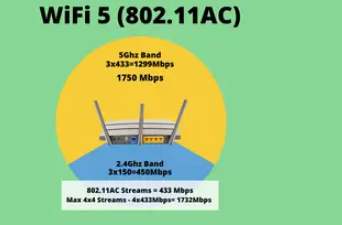Unleashing the Power of WiFi 5: Enhancing Wireless Connectivity
Introduction
In the fast-paced world of wireless technology, WiFi 5 has emerged as a game-changer, revolutionizing the way we connect to the internet. Also known as 802.11ac, WiFi 5 offers significant improvements over its predecessor, delivering faster speeds, increased capacity, and enhanced reliability. In this blog, we will explore the features and advantages of WiFi 5, as well as its impact on various aspects of our daily lives.

I. The Evolution of WiFi Standards
A. Understanding WiFi Standards
- WiFi standards are a set of specifications that define wireless network protocols and technologies.
- They ensure compatibility and interoperability between devices from different manufacturers.
B. WiFi 5: An Overview
- WiFi 5, based on the 802.11ac standard, represents a significant advancement in wireless technology.
- It operates in the 5 GHz frequency band and introduces several key features and improvements.
II. Key Features and Advantages of WiFi 5
A. Increased Speeds
- WiFi 5 provides faster data rates compared to its predecessor, WiFi 4 (802.11n).
- It uses wider channel bandwidths (up to 160 MHz) and advanced modulation techniques to achieve higher throughput.
- This enables faster downloads, smoother streaming, and improved overall performance.
B. Improved Multi-User Performance
- It utilizes multi-user MIMO (MU-MIMO) technology, allowing simultaneous transmission to multiple devices.
- This enhances the network’s capacity and efficiency, especially in crowded environments with multiple connected devices.
C. Beamforming
- WiFi 5 introduces beamforming, a technology that focuses the wireless signal directly towards the connected devices.
- It improves signal strength, range, and overall network performance, resulting in better coverage and reduced dead zones.
D. Backward Compatibility
- This is backward compatible with previous WiFi standards, enabling seamless integration with existing devices.
- This ensures that older devices can still connect to and benefit from networks, although at their respective maximum capabilities.
III. Impact on Everyday Use
A. Faster Internet Speeds
- It increased speeds translate into faster downloads, smoother video streaming, and improved online gaming experiences.
- It reduces buffering times and enhances overall productivity when performing bandwidth-intensive tasks.
B. Enhanced Home Networking
- It is well-suited for modern home networks, where multiple devices, such as smartphones, tablets, smart TVs, and IoT devices, coexist.
- Its improved multi-user capabilities and higher throughput ensure a seamless and reliable connection for all devices.
C. Enterprise Applications
- it enhanced performance and capacity make it ideal for enterprise environments.
- It supports the growing demand for bandwidth in office spaces, schools, shopping malls, and other public areas.
- it enables smooth video conferencing, faster file transfers, and efficient collaboration across multiple devices.
D. Public Wi-Fi and Hotspots
- Public Wi-Fi networks and hotspots can benefit from WiFi 5’s increased capacity and improved performance.
- Users can enjoy faster speeds and better reliability when accessing the internet in cafes, airports, hotels, and public spaces.
IV. Conclusion
WiFi 5, with its faster speeds, improved multi-user performance, and enhanced reliability, has transformed the wireless connectivity landscape. It offers a seamless and efficient internet experience for both personal and professional applications. As WiFi 5 continues to gain widespread adoption, users can expect better performance, increased network capacity, and enhanced user experiences. So, embrace the power of WiFi 5 and unlock the full potential of wireless connectivity in your everyday life.
